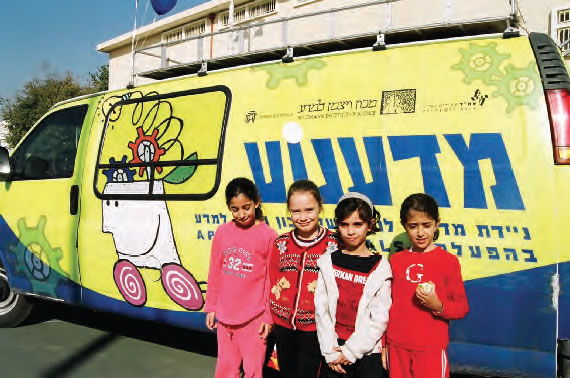
Children in front of the Science Mobile, which has been supported by Applied Materials, the Kennedy Leigh Charitable Trust, and the Naomi and Nehemia Cohen Foundation.
Stem cell research; droughts, floods, and other natural disasters; cell phone safety; energy-related issues such as hydraulic fracturing and nuclear plant regulation; organic versus conventional foods; ever-faster and more powerful technologies— these are just a few of the science-related subjects facing society today.
Given all this information, how are we to make sensible decisions that will not only protect us and our families, but improve our overall quality of life? The answer is through improved science literacy. As astrophysicist Neal deGrasse Tyson says, “When you’re scientifically literate, the world looks different to you. It’s a particular way of questioning what you see and hear. When empowered by this state of mind, objective realities matter. These are the truths of the world that exist outside of whatever your belief system tells you.”
Science has enabled society to advance and progress, and now is an integral part of our lives. We can hardly imagine surviving without the Internet, cars, or electricity. However, being able to make basic use of a scientific advancement—a medication, a computer, a fuel, a fabric—is very different from understanding what went into that development and what its implications are. In fact, in the U.S., this disconnect is becoming ever more apparent: as a recent story in The New York Times reported, most Americans are unable to even name a scientist, with a survey revealing that the top choice, at 47 percent, was Einstein, who has been dead since 1955. The next most popular choice, at 23 percent, was “I don’t know.” In another survey, only 4 percent of respondents could name a living scientist.
In order to ensure that humanity keeps moving forward, it is particularly critical that the next generations be scientifically literate. The Weizmann Institute of Science has, from its very beginning, recognized this imperative and has actively worked to advance science literacy, in Israel and abroad, in school and out, among children and adults. In fact, the Institute’s very origins—the initiative of the scientist-statesman Prof. Chaim Weizmann—set in motion the Institute’s strong emphasis on making science part and parcel of public life. While such programming may not be unique, few, if any, institutions have taken on the complicated task of educating the wider public to the extent that the Weizmann Institute has. In the process, the Institute has become more than a world-renowned research institution; it has become a force for science education.
“To my knowledge, no scientific institution in the world has such a variety, scope, and intensity of programming in science literacy,” says Prof. Haim Harari, Chairman of the Davidson Institute of Science Education at the Weizmann Institute and a former Weizmann Institute president.
These efforts are in addition to Weizmann’s main academic agenda of formal graduate education and cutting-edge research. So why did it take on this ambitious mission?
“The answer to ‘why Weizmann?’ is, ‘if not us, then who?’,” says Prof. Zajfman. “The answer to ‘why do it at all?’ is this: We live in a knowledge-based economy—we need to be conversant in science and math. Everyone must make informed decisions that involve science and technology all the time—whether it relates to the environment, medicine, high tech, education, you name it. And a democratic society depends on an informed public. But perhaps even more than the actual knowledge, it is important to transmit the curiosity that leads to it, and the questioning and investigating process, to the public, so that there is a culture of problem-solving in society.”
It all began with physics
In 1957, at the beginning of the Space Race between the Soviet Union and the U.S., a group of MIT physicists determined that raising the level of physics and technology education was too important to leave to the school system alone. They launched a flurry of curriculum-generating activity, including drafting a new high school physics textbook. One of the core members of the group was Prof. Uri Haber-Schaim, a former classmate of the Weizmann Institute’s Prof. Amos de-Shalit. During a sabbatical from MIT at Weizmann, Prof. Haber-Schaim and Prof. de-Shalit initiated a corresponding curriculum in Israel, including a translation of the new textbook into Hebrew.
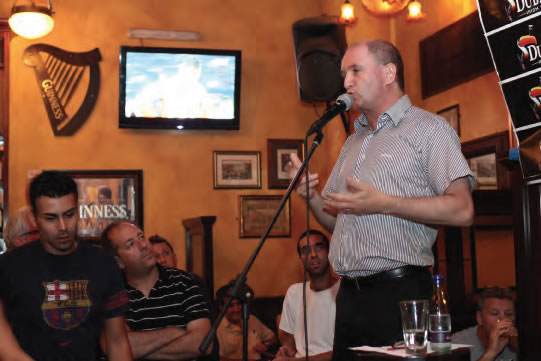
Prof. Daniel Zajfman shares the importance of science as part of the Institute’s Science on Tap discussion series, which is held at bars and pubs in Israel.
Prof. de-Shalit, the first head of the Institute’s Department of Nuclear Physics, had independently developed a similar ideology and was the Institute’s original advocate of improving the general public’s science knowledge: He understood that with the increasing influence of science and technology on our lives, science education must be brought to the people and imbued with excitement, and he believed that research scientists, who most embodied this spirit of curiosity and love of science, were the best equipped to take on this task.
In 1963, he recruited several high school physics teachers into a working group that would survey the level of physics education in Israeli high schools. Prof. Harari, then a 22-yearold graduate student, joined what was nicknamed the Rehovot Group. They determined that even though children study science from the first grade, the Weizmann Institute’s true added value was in educating the upper grades, when the science becomes heavy-duty. More importantly, recalls Prof. Harari, “The ideology that we arrived at was that we are not aiming just at the superstars but rather at the entire population. The high-tech industry didn’t exist at the time, but we had a strong sense that everyone should have a grasp of science at some minimal level.” The Weizmann Institute’s—and Israel’s—first teachertraining course was thus born, with graduate student Harari as its first instructor.
In 1968, the Department of Science Teaching was formed at Weizmann, led by Prof. de-Shalit and populated by a small group of scientists and schoolteachers dedicated part-time to writing textbooks in physics, chemistry, and math. The department took a holistic approach, developing teacher guides, teacher-training courses, and lab equipment for schools. Israel’s Ministry of Education adopted the curricula, which became widely distributed in schools across the country.
Prof. de-Shalit died in 1969 at age 43. Prof. Harari took over the department, followed by others. The work blossomed, and other universities began to develop science and math curricula for schools. To prevent duplication of efforts and to manage their funding, the Ministry of Education created the national Amos de-Shalit Center for Science Education. In 1974, the Amos de-Shalit Foundation was established with a mission of advancing science literacy among Israelis. Foundation activities include running summer camps, offering an annual lecture, and awarding a prize each year for outstanding high school physics students.
A five o’clock spectacle
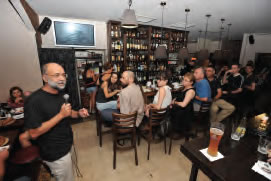
Prof. Israel Bar-Joseph is among the dozens of Weizmann scientists who have participated in Science on Tap.
It was also during those years that another Weizmann graduate student, Dr. Moshe Rishpon, was working with Prof. de-Shalit on a parallel track to advance science literacy from another angle: extracurricular youth activities. Dr. Rishpon’s idea was that the students most talented in science weren’t being challenged in the school setting; workshops and personal interaction with scientists would get them excited and involved with science.
After its start in 1964, the so-called Youth Activities Section thrived; the response was tremendous—from both scientists and students. “The scientists derived great satisfaction from sharing their fascination for scientific research with interested youth, and their mindset from the very beginning was to involve themselves in Israeli society rather than cloistering themselves in an ivory tower,” says Dr. Rishpon.
Extracurricular youth programs initially involved as many as 20,000 kids annually—led by about 200 Weizmann scientists and graduate students—in weekly science clubs, full-day intensive “field schools,” popular science lectures, science fairs, math Olympiads, and overnight summer camps. Tents for the overnight camps were replaced with solid structures when the Laub International Science Youth Village was built in 1993. “To truly grasp what we did in those years, you had to stand at the main gate of the Institute at around five o’clock—it was the changing of the guard,” recalls Dr. Rishpon. “The scientists would trickle out, leaving for the day, while huge swarms of children poured in to begin their activities.”
As a graduate student, Prof. Israel Bar-Joseph, now Professor of Physics and Vice President of Resource Development and Public Affairs, was one of the instructors; as a high school student, he had participated in some of the youth activities. “The youth programs ensured that the science knowledge didn’t just stay within the confines of an elite group of professors and graduate students,” he says.
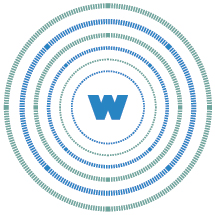
While such programming may not be unique, few, if any, institutions have taken on the complicated task of educating the wider public to the extent that the Weizmann Institute has. In the process, the Institute has become a force for science education.
“It’s astounding how much Weizmann’s Sparks of Science program has contributed to my knowledge and self-esteem.” —Esther Wobgan, Sparks of Science program graduate
When asked to name a scientist, this is what Americans had to say.
Nearly
50%
said Albert Einstein, who died in 1955
23%
said “I don’t know”
only
4%
could name a living scientist
The New York Times,
August 8, 2011
Many other Weizmann scientists were formerly students in the Youth Activities Section. For example, Dr. Kobi Abramson, who joined the Department of Immunology earlier this year, visited from his native Prague as a teenager to attend the summer camp for international students. He says the experience “set me on a path to become a research scientist,” and he returned for a PhD. While at Harvard for his postdoctoral research, he received job offers from several universities, “but I was drawn back again to Israel, and to Weizmann.”
In 1998, Dr. Rishpon, while pursuing his PhD and then working as a research scientist, founded the Clore Garden of Science. The garden, an interactive open-air science museum for all ages, has become a huge success and is a popular tourist destination. Children (and others) play on, in, and with the exhibits, all the while learning about scientific principles. The museum has some 70 exhibits, hosts about 70,000 visitors a year, and includes the Joe Weinstein and Major Max L. Shulman EcoSphere, which demonstrates principles of ecology and facilitates study of the environment.
It was in this creative, altruistic environment that PERACH was founded by Prof. Harari and a graduate student named Rony Attar. The program offers students from all Israeli universities a half-price break on their tuition in exchange for tutoring and mentoring underprivileged but promising youth. To date, one million Israelis have been involved, and it has been duplicated in 20 countries. Now funded by the government (and not science-specific), PERACH is still headquartered at the Weizmann Institute and “is indicative of the Institute’s approach of reaching beyond its walls to educate the public,” says director Amos Carmeli.
Indeed, by the early 1990s, the campus was overflowing with youth programming. To ensure that the Institute maintained formal graduate education and research as its first priority, but without compromising the success of the science literacy programming, it was decided that a separate nonprofit entity for this programming would be created and housed—symbolically—at the edge of campus.
“The answer to ‘why Weizmann?’ is,
‘if not us, then who?’” —Prof. Daniel Zajfman, President, Weizmann Institute
However, such an endeavor requires large investments of resources, including time, personnel, materials, and money. Thanks to a transformational $20 million gift from visionary Detroit philanthropist Bill Davidson, the Davidson Institute for Science Education was born. Airy, modern buildings were constructed, all nonacademic programming was merged into the Davidson Institute, and new initiatives were launched.
Today, Davidson’s myriad programs attract more than 300,000 students and teachers annually and are geared toward four groups: low achievers and at-risk youth; talented youth; the general public; and teachers (professional development). Several initiatives cater to international groups, like the Dr. Bessie F. Lawrence International Summer Science Institute, a four-week camp for high school graduates who are gifted in science.
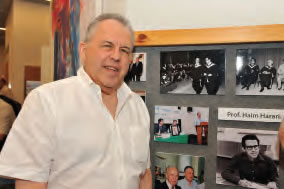
Prof. Haim Harari, Chairman of the Davidson Institute of Science Education and a former Weizmann president, was an instructor in the Institute’s first teacher-training course more than four decades ago.
Esther Wobgan, a graduate of the Sparks of Science program for talented immigrant youth, is one of countless success stories. The youngest of 11 children, Esther joined the program in junior high after showing early promise in school, despite her family’s hardships after immigrating from Ethiopia in 1991. “Throughout my years in the program I was exposed to the world of science; it’s astounding how many new things I learned and how much this program has contributed to my personal knowledge and self-esteem,” recalls Esther. Today, she is the only one of her siblings to have gone to university.
Another compelling program is the Weizmann Institute’s Science Mobile (“Madanoa” in Hebrew), which takes to the road to reach schools in outlying areas, such as in Israel’s periphery, or that lack the resources to provide students with a high level of science activity. This traveling science lab—a van equipped with scientific exhibits and educational aids—is run jointly by Davidson Institute staff and Weizmann graduate students who serve as instructors, teaching science and conveying the excitement of scientific discovery to students and teachers. In the past year, the Science Mobile extended its reach to about 8,000 students in 68 schools. Participants now include elementary, junior high, and high school students, as well as hospitalized children and those with special education needs—with each program tailored to its audience. This year the mobile will also travel to military bases, offering science enrichment to soldiers.
“The feedback is always that the kids have a challenging and exciting learning experience,” says Dr. Hannah Mergel, who heads and coordinates the scientific activities of the Science Mobile. “The instructors are also inspired by the opportunity to meet kids from the periphery and by the opportunity to spread the love of science across the country.”
As the world around us keeps changing, the Davidson Institute keeps adapting its programs to meet today’s demands; for example, this year it launched a new, interactive, Hebrew-language science education website called Davidson Online. Backed by a gift from Israeli donors Tova and Sami Sagol, the site is geared toward Israeli junior high and high school students and the general public. Future plans call for a parallel English language site, which will open the door to students and science educators around the world. “The English version of the Davidson Online website will address and engage students and teachers worldwide with a wide range of scientific and didactic material,” says Davidson Director-General Dr. Ariel Heimann.
Science from all angles
One of the newest initiatives is the Rothschild-Weizmann Program for Excellence in Science Teaching, funded by the Rothschild Caesarea Foundation. The program offers advanced professional enrichment to high school teachers in Israel and awards MSc degrees; a second track offers post-MSc professional development. The participants report a new-found confidence in their ability to encourage students’ curiosity and discussions in class. For Hagit Bergman, a high school biology teacher who graduates this year, the program has also rekindled an enthusiasm for her profession. “The innovations in science and teaching opened for me a window to a world of beauty and magic, re-coloring my biology lessons,” she says. “It has been a true privilege to take part in this program.”
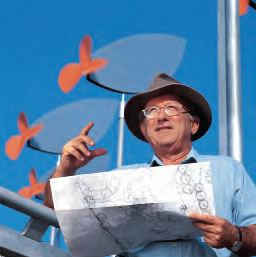
Dr. Moshe Rishpon initiated the Institute’s youth extracurricular programs as a Weizmann graduate student. He later founded the Clore Garden of Science.
Science lectures and clubs for the general public come in all stripes and include the Annual Ephraim Katzir Lecture, named after one of the Institute’s founding faculty members and Israel’s fourth president, which hosts hundreds of high school students. Last April, in an evening dubbed “Science on Tap,” 40 Institute scientists gave informal talks about science at 40 bars in Tel Aviv; in July, scientists took up the microphones at bars in Rehovot for the second year running. The events had overwhelming turnout. The Institute also publishes a comic book series called Nano Comics.
On Fridays, themed walking tours of the campus are offered to the public at no cost through the Barbara and Morris Levinson Visitors Center. These tours cover campus architecture, trees and gardens, sculptures, and “Vera’s Salon”—an up-close look at the life and home of Vera and Chaim Weizmann. As of November, the Visitors Center is located in the new David Lopatie Conference Centre, featuring a state-of-the-art multimedia experience that kindles curiosity about the Weizmann Institute and about science and the nature of humanity and the universe.
Even in tangential ways, the Weizmann Institute has influenced science literacy in Israel. When Israel Educational Television began in the mid-1960s, it turned to Weizmann faculty members. In the early 1990s, the Israeli government declared science education a top priority, and asked Prof. Harari to chair the national committee on science education.
HEMDA, the Centre for Science Education, was the brainchild of the Rothschild Foundation and Prof. Harari; President Zajfman is its current chairman, although HEMDA is a separate nonprofit. In this unique regional model of science education, advanced science students from 17 Tel Aviv high schools get their physics and chemistry lessons at HEMDA. Backed by philanthropic and municipal funds, the school has state-of-the-art equipment and a highly trained teaching staff with advanced degrees—something no single school could offer. The Weizmann Institute is in the process of building a new HEMDA in Rehovot.
Weizmann’s efforts to promote scientific literacy reach beyond Israel’s borders; for example, Blue Planet, a curriculum package for middle school students about the link between man and the environment, written by Weizmann Institute scientists, won recognition by UNESCO as a global model in environmental studies. This international organization is promoting and financing the translation of the program into various languages, as well as its distribution in schools worldwide.
“Science literacy isn’t just about teaching science while sitting in a classroom,” says Prof. Zajfman. “It’s about science being just as much a part of all our lives as art or sports or culture. We’re not trying to turn everyone into a scientist, but we are saying that science should play a role in everyone’s life, whether it is a tool to help lift up at-risk youth, help politicians make informed decisions, or enable industry to flourish. In the end, society thrives.”
